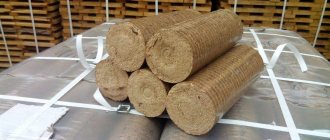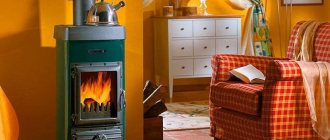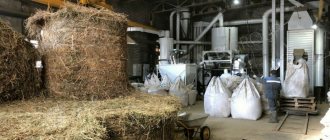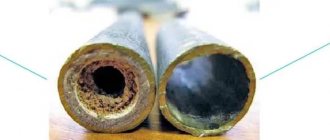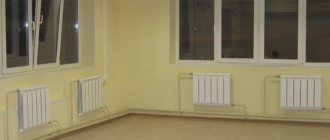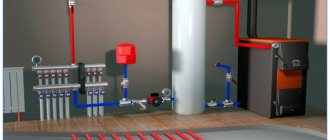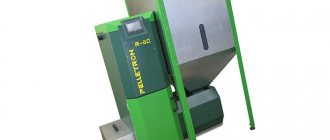Since ancient times, the population heated stoves with coal and wood to heat their homes. However, progress does not stand still and humanity has come a long way in all spheres of its life. The synthesis of scientific developments and modern, high-tech production has made it possible to create a new type of solid fuel - briquettes for heating.
For their production, various raw materials are used - peat, waste from the wood processing industry (sawdust, shavings), agriculture (straw, husks), residues from coal production. The scope of application of briquetted fuel is quite large and varied: heating saunas, industrial and residential premises, heating greenhouses, heating coolant in boiler rooms.
How to compare the cost of fuel briquettes with the cost of firewood?
As you know, firewood is most often sold in bulk or stacked.
If you received stacked firewood on pallets, then a cubic meter of such firewood is equivalent to 0.7 cubic meters in terms of dense wood. If you were brought firewood in bulk in the back of a truck, then with a firewood length of 30-35 cm, the cubic meter will contain only 52% dense wood. In other words, to compare the cost of bulk firewood for dense wood with the cost of fuel briquettes, the cost of firewood should be doubled.
So, let's compare prices. Bulk firewood in the Leningrad region costs 1,500-1,600 rubles. per cubic meter. In terms of dense wood, a cubic meter of firewood will cost 3,000-3,200 rubles. In neighboring areas, firewood can cost about one and a half times less. Thus, a cubic meter of Ruf type fuel briquettes costs the buyer, depending on the area, 2-3 times more expensive than firewood.
We decided to find out whether such a difference in price is worth the stated advertising advantages of fuel briquettes in the form of convenience, increased heat transfer and increased burning time of fuel briquettes. We conducted an amateur experiment, which, although it does not claim to be scientifically reliable, can clarify some aspects of the use of fuel briquettes instead of firewood.
Business in the production of fuel briquettes.
The cost of traditional energy resources is constantly growing, so the number of consumers of fuel briquettes is steadily growing.
If there is availability of raw materials, this primarily concerns owners of wood processing enterprises and farmers; a business on fuel briquettes will be quite attractive and will allow you not to depend on the purchase of raw materials.
To produce products for the domestic market, you can use domestic equipment, especially since its price is significantly lower than imported equipment. But if production is focused on the European market, where the requirements for fuel briquettes are much stricter, higher quality imported equipment will be needed.
Share this business idea on social media. networks
Pros and cons of using fuel briquettes
The advantages of the new fuel are clearly revealed when it is compared with classic firewood. First, it’s worth discussing the benefits received:
- High calorific value. When burning, pressed sawdust releases 2–3 times more heat per unit weight.
- Increased burning time. Compared to ordinary wood, fuel briquettes last 1.5–2 times longer, which, coupled with the first advantage, allows you to save on heating.
- Environmentally friendly and harmless. No chemical reagents are used during creation; the production of European firewood itself utilizes part of the waste from wood processing factories.
- Low resin release. The chimney needs to be cleaned 2 times less often than when burning wood.
- Less noise, smoke and embers flying to the sides. Sawdust briquettes burn evenly, less smoke is released during the process, and after that there is not as much ash left as from ordinary firewood.
- Ease of storage and use. The shape of the briquettes allows for a minimum of space for storing them, and it is also optimally suited for use in boilers with automatic fuel supply.
- High density. This means that with the same volume, the mass of fuel will be on average 3 times higher than that of firewood. Convenient for transportation, the truck will transport more payload at a time.
- Low moisture content. Such sawdust fuel has a moisture content of about 10%, while dry firewood has a moisture content in the range of 20 to 25%. Euro-firewood has less useless water in weight, and less heat is used to evaporate it.
Comparison of Eurowood with other types of fuel
Flaws:
- Relatively high cost. Buying sawdust in briquettes will cost more than the same volume of firewood.
- Be afraid of interaction with water. When storing, it is necessary to ensure that fuel blocks are protected from moisture.
- Limited shelf life. Some manufacturers indicate a maximum shelf life of 1–3 years. During this period, fuel must be used;
- Distribution problems. In some regions, compressed sawdust is not used for heating due to the lack of a supplier.
- Fragility. Fuel briquettes are not very durable and can crumble under mechanical stress, especially for low-quality products, which, unfortunately, are now widely represented on the market.
- The smell is from ash. Ash from burnt fuel briquettes has an unpleasant, tart odor.
- No clicking. For some, this may be a disadvantage, because people associate this sound with warmth and comfort, it’s just a psychological feature.
What is more profitable – firewood or briquettes?
Since price is one of the most exciting characteristics for the end consumer, the review should begin with it.
1 m3 of fuel in briquettes costs approximately 2 times more than firewood. However, the cost can vary even more depending on the quality of the compressed sawdust and the type of wood of the logs. Throughout the analysis, average indicators for both types of solid fuel will be compared. Euro firewood burns 2 times longer, so its weight consumption is significantly lower. So far it turns out that economically there is no difference - they cost 2 times more and last 2 times longer.
At the end of the fire, a lot of coals and ash remain from the firewood in the stove, and the eurowood burns out almost completely. The ease of servicing heating equipment with fuel briquettes is much higher.
Among the pressed sawdust sold on the market, a significant proportion does not meet high quality standards, has a lower density and is too easy to crumble. But even with firewood, everything greatly depends on the supplier; they are often shipped to the buyer raw, with a humidity of up to 50% and from a different type of wood. One - one, low-quality goods can be bought both there and there with approximately equal probability.
Comfort when using briquettes is definitely higher. No need to chop or dry the wood. When stored, Euro firewood takes up much less space and can carry a larger amount of fuel at a time.
Taking into account all that has been said, fuel briquettes really turn out to be a little more profitable than their natural counterparts. This is especially evident in heating systems with coolants and automatic supply of fuel to the combustion chamber.
Peat and coal briquettes
Briquetted peat fuel is good for use in furnaces and boilers with controlled air supply. Gives a stable powerful flame. It has a high ash content. Peat briquettes smoke more than regular dry firewood. However, the combustion duration is twice as long. This type of fuel is especially popular in regions where there is an abundance of peat, and it costs less than regular firewood.
Such fuel does not have very high heat transfer. Summer residents use the ash left over from the combustion of peat briquettes to fertilize their garden plots.
The shape and density of coal briquettes affects the duration of combustion. However, compared to ordinary coal, after burning coal briquettes, only 3 percent of ash remains (from hard coal 10 percent).
Charcoal briquettes cannot be used for barbecues. The requirements for the premises where the boiler operates using coal briquettes are quite stringent. Therefore, this type of fuel is usually exchanged in industrial boiler houses.
What is better - firewood or fuel briquettes?
Now briquette fuel, or pellets, is quickly gaining popularity among owners of cottages, dachas, and country houses. And this is not surprising, because, unlike ordinary firewood, briquettes do not require splitting, and during the combustion process they do not produce acrid smoke, ash and dirt. In addition, the efficiency of briquette fuel is five times greater than that of traditional fuels.
Briquette fuel burns twice as long as regular logs. This is preferable for stoves with a long burning period. And in stoves or fireplaces with a fast combustion cycle, it is better to use wood, given their high heat output.
Features and types of peat
Peat is an organic rock that is the result of the biochemical process of rotting marsh plants due to excessive humidity and oxygen deficiency. Peat includes plant fibers, humic acids and various microelements.
If we look at peat as a fuel, taking into account its main characteristics, then it can safely be called young coal. In terms of basic parameters, they are similar, however, peat extraction does not imply the creation of a complex developed infrastructure, because of this, its cost is significantly lower compared to coal.
The main feature of peat is its ash content. It refers to the amount of combustible products that remain after burning a kilogram of fuel. This parameter is measured as a percentage.
The ash content of peat also depends on its origin. Based on this, three types of this breed can be named.
| Type of peat | Peculiarities |
| Lowland | Consists of a large amount of rotted wood residues. It has a very high ash content (for some species it can reach 50%) and low thermal capacity. Because of these characteristics, it is often used in the preparation of natural fertilizers for clay soils. |
| Horse | The basis is the remains of marsh vegetation and sphang mosses. It has a low ash content of 1-5%. This peat is most often used for domestic purposes; it is most often used as the main raw material in the production of fuel. |
| Transition | This is something between lowland and highland peat. |
Of course, peat is not used as fuel in its pure form. After extraction, the natural material undergoes special processing, allowing rational and effective use of all its properties.
Therefore, the following types of peat can be distinguished depending on the characteristics of its processing.
| Type of peat | Peculiarities |
| Shredded/milled peat | This is a placer that is intended to be burned in suspension. |
| Semi-briquette / sod peat | Characterized by a low degree of compression, this fuel product is produced directly on the site of the deposit being developed. |
| Peat briquette | This is a high-calorie product with a significant degree of pressing. Due to the characteristics obtained as a result of processing, it is able to replace coal. A ton of peat briquettes in terms of the volume of heat generated is equal to 1.6 tons of brown coal and 4 m³ of firewood. Peat briquettes are stable in their thermal characteristics, this makes it possible to make accurate calculations of the fuel needs of a certain object. |
You can learn more about the manufacturers of fuel briquettes Ruf, Pini Kay, Nestro and Nilson on this page.
Which fuel briquettes burn better and last longer?
Euro firewood differs from each other only in shape and material of manufacture. Wood briquettes made from sawdust burn better and longer than others, if we talk about the material used.
There are three main forms of fuel briquettes, which will also have different calorific values:
- Roof - produced in the form of bricks, have a small size and low density - 0.7 - 0.8 grams per cubic centimeter. They are easy to use and have high calorific value. This is an average price-quality ratio;
- Pini-kei - the cross-sectional shape resembles a square or hexagon with a through hole for better air movement and combustion. They have a high density of 1.08 to 1.4 grams per cubic centimeter. Such products are characterized by special surface firing, due to which these briquettes are more durable, and they burn longer and better. Pini-key briquettes are number one among analogues;
- Nestro is produced in the shape of a cylinder and has an average density of 1 to 1.15 grams per cubic centimeter. Such briquettes have a low cost and, accordingly, burn out faster than the analogues described above;
Do it yourself or to order?
Owners of country houses in most cases are enterprising people and can build anything with their own hands, but is it necessary to do this?
Making custom cabinets under the stairs is more expensive than doing the design yourself. But in this case, the owner will receive not only a high-quality piece of furniture, created taking into account all the possibilities of space and wishes, but also a guarantee for the product.
Staff
The specifics of the matter are such that working alone or with one or two assistants is irrational. Therefore, the following employees must be included in the business plan for the production of fuel briquettes:
- director of the enterprise (also head of production) - 1 person;
- chief accountant - 1 person;
- shift supervisor (also known as equipment adjuster) - 3 people;
- production operator - 3 people;
- full-time workers - 9 people.
The list is based on the assumption that your employees will work in three shifts. You shouldn’t save money or reduce staff, for example, hire an accountant who works remotely: this is only possible when managing small companies. You should also hire drivers and support workers - at least two people each. By alternating shifts, you can ensure the plant operates 360 days a year.
Back to contents
How peat briquettes are made
Technologically, the production of peat briquettes is not complicated.
The process looks like this:
- by milling the top layer of biomass, peat crumbs are obtained;
- the raw materials are passed through agitator and drying machines, where they acquire the required percentage of moisture content;
- dried granules are laid out in certain forms and dried to achieve a moisture content of no more than 12%;
- then the mass is separated and passed through a press;
- During processing at temperatures of +200 C ... +350 C and increased pressure, the workpieces are melted and formed into briquettes with a high degree of strength.
Standard briquettes for solid fuel boilers have the following parameters:
- size 150x70x60 mm;
- sulfur content not more than 0.2%;
- ash impurity content no more than 15%;
- calorie content from 4500 - 5500 kcal/kg;
- humidity within 18%.
In addition to milling mining technology, lump procurement of raw materials is used. The process takes place in the development areas, attachments are used on a tractor, and pressing is carried out on the field in natural conditions. This fuel is characterized by its loose shape and low heat transfer.
Necessary equipment
As it becomes clear from the technology described above, to produce briquetted fuel you will need appropriate equipment, which is easy to make with your own hands. The main device is a press, which ensures the formation of a briquette from a crumbly raw material mass, characterized by a dense and uniform internal structure. A screw, lever or hydraulic mechanism can be used as a force body, with the help of which pressure will be applied to the raw materials used to produce fuel briquettes.
- drive mechanism, which, as mentioned above, can be screw, lever or hydraulic;
- a supporting frame on which all structural elements of the device are fixed;
- a matrix in the internal cavity of which a fuel briquette is formed from a loose raw material mass;
- a punch through which pressure is applied to the raw material mass;
- mixing drum (all components included in the raw material mass are mixed in it);
- trays designed for loading raw materials into the matrix and unloading finished products from its working chamber.
Scheme of a homemade impact machine with an electric drive
3D model of the shock-mechanical part of a press for the production of briquettes
To make briquettes from sawdust or any other suitable raw material, one press is not enough: this will also require auxiliary equipment:
- a crusher, with the help of which pre-cleaned raw materials will be crushed to fractions of the required size;
- mesh trays on which the finished briquettes will be dried;
- a ventilation unit necessary to remove the resulting dust from the raw material grinding zone.
Homemade biomass chopper based on an electric drill with a mixer attachment
You can produce Euro firewood yourself not only using screw, lever or hydraulic pressing equipment, but also using other types of technical devices. In particular, it is possible to use briquetting equipment of the impact-mechanical and extrusion type.
Like screw and lever type devices, briquetting equipment operating on the shock-mechanical principle belongs to the category of the least expensive in terms of self-production. When using such equipment, as when using screw and lever type devices, the produced fuel briquettes are not very dense, which makes them not very resistant to high humidity and significantly reduces their heat transfer level. In addition, such briquettes for heating, characterized by a rather loose internal structure, are unstable to mechanical damage, which eliminates the possibility of their transportation over significant distances.
Factory-made press VT60
The technology, which involves the use of extruder-type pressing equipment, is used primarily for the production of Euro-firewood in production conditions. A fuel briquette made using such equipment is characterized by a dense internal structure and, accordingly, high resistance to mechanical damage. When using extruder equipment, the pressure on the pressed raw material is exerted by a screw, which, rotating, moves the bulk mass to the holes of the matrix and pushes it through them. As a result, dense bars of cylindrical or hexagonal shape are formed.
Hydraulic press Green-440 for the production of briquettes RUF
To produce fuel briquettes using an extruder press, you do not need to add binders to the raw material. Such equipment, due to the peculiarities of its design, is capable of providing enormous pressure on the pressed raw materials, as a result of which the natural substance lignin is released from the latter, which acts as a binding component.
If you decide to make this type of pressing equipment with your own hands, keep in mind that this is a rather expensive undertaking, as it requires the use of expensive materials and special devices. That is why the option of independently manufacturing extruder-type pressing equipment is not often considered by home craftsmen.
Which fuel is more profitable?
When choosing between briquettes and regular firewood, you should take into account the cost of these types of fuel.
For example, in Moscow, one cubic meter of briquette fuel varies within 6 thousand rubles, and for the same volume of wood you will have to pay approximately 3 thousand rubles. However, in the total mass of logs, as a rule, about a third can be low-quality, raw products. Considering that the heat transfer from burning logs is much lower than from briquettes, the benefits of using briquette fuel are obvious.
Cow dung shortage has put the health of 120 million women at risk!
The female population in Indian villages belonging to the reproductive age group is 150 million.
These women need care during pregnancy and assistance during childbirth, as well as in the postpartum period.
For centuries, in Indian villages, experienced midwives provided the necessary care to women in labor in accordance with the proven principles of Ayurveda, the ancient Indian medicine.
The two main treatments used by midwives were massage using oil and compresses made from heated cow pats. Midwives used to perform these procedures on the woman and the newborn baby within 40 days of birth.
However, cow dung has now become a rarity. Oil has also become more expensive, and for many women from poor families, Ayurvedic treatments are no longer affordable...
And with the unavailability of Ayurvedic remedies, there is no need for the services of Ayurvedic doctors and midwives. Tens of millions of Indian and Muslim midwives are losing their ancient, hereditary, much-needed profession.
In the current situation, in the absence of timely medical care, tens of millions of women suffer from complications during childbirth, often these complications result in chronic diseases that then haunt women throughout their lives.
It is surprising that so far neither various charitable and public organizations that care (in words) about women’s health, nor Ayurveda specialists, nor women’s organizations have expressed protest in connection with such neglect of the health of mother and child! No one drew attention to these problems!
So, in practice, Western philosophy and the value system have borne fruit only in the form of a deterioration in women’s health and their acquisition of so-called “freedom”, in a unique, however, understanding - freedom, expressed in the right of women to immoral behavior, shamelessness and abortion.
What are peat briquettes (video)
Is there a new generation of fuel alternative to traditional firewood? What is its calorie content? Is it possible to make equipment for the production of peat briquettes with your own hands? How much does a cube of briquettes weigh? All these issues are actively discussed on forums and indicate that interest in peat briquettes is growing and their popularity is increasing.
Comments
-1 Yulia 12/28/2017 21:02 I have been buying exactly these briquettes for many years, they are convenient to use and store. At the same time, there is quite a lot of heat when they burn. They don't cost that much, considering that you only need a small amount of them. Quote
0 Daniil 12/23/2017 07:18 Really excellent fuel, burns long and evenly, there is no such intense heat as from wood or coal, but it provides excellent heat and is economical in costs. I bought it last winter, it lasted me all winter, but I couldn’t find it anywhere for this winter, they weren’t on sale.
Quote
0 Katya 12/08/2017 21:04 This is the second year I have been buying peat briquettes, they are really profitable to buy. They burn for quite a long time, so consumption is economical. I think this is currently the best fuel for the money.
Quote
Update list of comments RSS feed of comments for this entry
Features of the technological process
Fuel briquettes are a modern material that has great prospects. Due to their compactness, environmental friendliness and ease of use, they are becoming increasingly popular, and the production of briquettes for heating is a profitable business. This raw material is effective because it burns longer and heats the room longer because the heat is released continuously. When they burn, there is practically no smoke. Briquettes with a through hole in the middle promote better fuel combustion. The use of this material is advisable in countries where climatic conditions are severe.
The production of briquettes for heating is carried out on the basis of the following equipment:
- machine for shredding wood waste;
- press;
- machine that packages finished products.
There are also automated lines for the production of briquettes, and the variety of equipment allows you to optimize this process, which is simple.
Production
The production process, as we have already said, is quite simple, even though it takes place at home.
To make briquettes for heating stoves with your own hands you need:
- Prepare high-quality raw materials, grind them to the desired consistency, and dry them. In order to improve the quality of combustion, paper can be added to any raw material.
- If necessary, add a binding element (clay, lignin), add water, and load it into the press machine.
- Press the product into a suitable shape at high pressure and preferably high temperature.
- Dry the finished product and, if possible, package it to protect it from external factors. When drying, you can use rags and paper that can draw out any remaining moisture from the briquette.
Having carried out all this work, you will receive excellent fuel, which can be used to easily and quickly heat a bathhouse and heat a house. At the same time, over a long period of time, you will experience the benefits and cost savings from using such eco-drives.
Note that during operation you should try to achieve a briquette moisture content of no more than 10-12% so that they burn well. Industrially produced briquettes have a moisture content of less than 10%.
To make sure of the excellent characteristics of this type of fuel, you can buy yourself some Euro briquettes to try in any store. At the same time, to create a suitable atmosphere, you can sometimes light a fireplace or stove with ordinary wood, because the use of different types of fuel is not mutually exclusive.
Back in the middle of the last century, in many regions of our country, where there were problems with wood, but livestock farming was developed, dung was a popular type of fuel. Then they were supplanted by coal supplies and gasification, but the topic of producing fuel briquettes from manure is still interesting.
Nowadays, manure is most often used in organic farming, as a natural and useful fertilizer. But these are not all areas of use of this natural raw material. We talked about adobe houses, where manure can also be used as a filler for construction briquettes. In addition, organic material is used in the production of biogas, which is also an alternative fuel.
Preparation of dung. Tsimlyanskaya village, 1875–1876
But we will not talk about biogas, but specifically about fuel briquettes made from manure, dung, which were actively used by our ancestors to heat houses with stove heating.
Dung is not just manure, animal waste. This is manure mixed with straw, sawdust, hay, pressed into small briquettes, bricks or cakes, and dried. In this form, manure becomes a good fuel for heating, for example, a greenhouse, a bathhouse or a country house, completely replacing firewood and even coal.
For comparison, here are the approximate energy content of various types of biological fuel:
| Fuel | MJ/kg | kW h/kg |
| Dry manure | 16 | 4,4 |
| Fresh wood with 60% moisture content | 6 | 1,7 |
| Street-dried wood with a moisture content of 20%, ordinary firewood | 15 | 4,2 |
| Straw in bales | 15 | 4,2 |
| Coal | 28 | 7,8 |
As you can see, the specific calorific value of dry manure is even slightly higher than that of firewood that was dried outside. In addition, dung burns with a smoldering flame; users note that their combustion properties are similar to brown coal.
The main advantage of manure as an alternative fuel is its efficiency. If you have your own farm - cows, goats, sheep, rabbits, other animals - then the fuel is absolutely free. You can ask your neighbors who farm and do not actively use manure themselves. A whole truck of manure can be ordered and purchased; it will cost about 11 thousand rubles.
Another plus is that ash from dung will be an excellent fertilizer; it is an environmentally friendly and waste-free fuel.
The main disadvantage of dung is that it takes a long time to make such fuel with your own hands; you have to put in a lot of effort. In addition, the very thought of having to tinker with such organic raw materials, animal feces, scares many people away. Note that, according to numerous reviews, there are no unpleasant odors during the burning of dung. Bread was previously baked in Russian ovens using this fuel.
In the process of producing briquettes from manure, of course, there is little pleasant, we agree. But in general, everyone involved in livestock farming is faced with the disposal of organic waste, so why not do it for the benefit of the farm.
Humus production
The transformation of sawdust into humus is a natural result of the work of various bacteria, which break down cellulose into simple organic substances, and also perform many other actions.
Therefore, the speed of obtaining humus, as well as its quality, directly depend on the conditions created for these bacteria.
In addition, the composition of the source material is very important - processing wood waste alone allows bacteria to turn it into a good nutrient, but will not supply the soil with the substances and microelements necessary for plant growth.
The process of producing fertilizer from sawdust begins when the following conditions are met:
- positive temperature and sufficient humidity;
- oxygen availability;
- presence of a minimum number of bacteria.
For the life of bifidobacteria, which break down cellulose into glucose and other substances, nitrogen is necessary, which they absorb from the air and soil. The nitrogen contained in the air is not enough for the active activity of bacteria, so their activity is low.
You can increase it by adding:
- urea;
- land;
- droppings or manure.
During the activity of bacteria, a lot of carbon dioxide is released, so the process of turning compost into humus should only take place in the open air.
In addition, the bacteria that turn sawdust into humus emit a lot of heat, so the process does not stop even at sub-zero temperatures.
However, as the temperature drops, the bacteria living in the outer layer of the compost heap reduce their speed of work, so the rotting process occurs less evenly.
But the high temperature inside the pile allows bacteria to transform material in the outer layers of the pile.
In addition to processed cellulose and other organic matter, the compost should also contain inorganic substances, primarily calcium and phosphorus.
During the life of bacteria, they mix as much as possible with humus and form compounds that are optimal for plant nutrition.
Comparative characteristics of briquettes
| Type of fuel | Calorific value, MJ/kg |
| Anthracite | 26,8-31,4 |
| Brown coal | 10,5-15,7 |
| Coal | 20,9-30,1 |
| Gas | 27 |
| Peat (humidity 20%) | 15,1 |
| Diesel fuel | 42,7 |
| Wood (humidity 40%) | 6-11 |
| Briquettes (from sawdust) | 16-29,5 |
Each type of briquettes has its own characteristics and advantages. And although all of them are excellent for heating in domestic conditions, it is still worth familiarizing yourself with their characteristics in more detail in order to choose the best option.
Forms of fuel briquettes
Wood briquettes
This type of briquettes is obtained by pressing various wood waste - dead wood, sawdust, shavings, substandard wood. Before pressing, the waste is heated to a certain temperature, as a result of which an adhesive substance, lignin, is released from the cells. Thanks to lignin, briquettes acquire high strength and retain their shape during transportation and storage.
Wood briquettes
The advantages of briquettes over solid wood are obvious:
- the density of briquettes is constant and amounts to 1240 kg/m³, the density of wood depends on the species and ranges from 150-1280 kg/m³;
- maximum humidity of briquettes is 10%, wood – from 20 to 60%;
- when burning a briquette, the volume of ash is 1% of the total mass, wood - 5%;
- when burning, a briquette emits 4400 kcal/kg, wood - 2930 kcal/kg.
In addition, wood briquettes have other advantages:
- pressed wood does not spark when burning and emits very little smoke;
- a constant temperature is maintained in the boiler;
- briquette burning time 4 hours;
- the coals remaining after combustion are excellent for cooking over an open fire;
- the correct shape of the briquettes simplifies their transportation and storage.
Such fuel is sold not in cubic meters, like wood, but in kilograms, which is much more profitable.
Prices for Eurofirewood Briquettes
Eurofirewood Pini-kay
Coal briquettes
Coal briquettes
This type of briquettes is obtained from screening out coal. First, the screenings are crushed, mixed with a binder, and then compressed under high pressure.
The main properties of such fuel:
- coal briquettes do not smoke;
- do not emit carbon monoxide;
- burning time in conventional boilers is from 5 to 7 hours, with controlled air supply – 10 hours;
- suitable for use in domestic conditions;
- have a compact shape;
- when burning they release 5200k/cal and maintain a constant temperature;
- maximum ash volume – 28%;
- have a long shelf life.
Coal briquettes are the most optimal fuel in harsh winters, when pressure drops in domestic gas systems due to low temperatures. Briquettes burn at any temperature, the main thing is that there is a constant flow of air.
Prices for WEBER coal briquettes
WEBER coal briquettes
Peat briquettes
Peat briquettes
To make briquettes, peat is dried, heated and pressed under high pressure. The result is neat, light, dark-colored bricks. With an adjustable air supply, peat briquettes maintain the temperature for 10 hours, which is very convenient for heating the house at night.
Basic properties:
- suitable for all types of ovens;
- heat transfer is 5500-5700 kcal/kg;
- ash volume 1% of the total volume of the briquette;
- affordable price;
- minimum amount of impurities in the composition.
The ash that remains after fuel combustion can be used as an effective lime and phosphate fertilizer. For many owners of private households, this factor is decisive when choosing heating briquettes. Since peat is a flammable substance, it should be stored at a safe distance from open fire and heating devices. Even dust spilled from the packaging can ignite and cause a fire, so briquettes must be handled correctly.
Husk briquettes
Husk briquettes
Sunflower husks, buckwheat and rice husks, rye waste, oats and even straw are widely used to make fuel briquettes. The most common are briquettes made from sunflower husks, since the production of oil leaves a large percentage of waste. The maximum moisture content of husks for pressing is 8%, which increases heat transfer and reduces combustion time.
Sunflower briquettes
Specifications:
- briquette density is 1.2 t/m³;
- heat transfer – 5200 kcal/kg;
- ash volume from 2.7 to 4.5%.
Additional benefits:
- absence of harmful impurities;
- affordable price;
- long burning time;
- ease of storage and transportation.
Which is better: fuel briquettes or firewood?
Wood briquettes, like any other product, have both their pros and cons. What is the best and most profitable way to heat, what kind of firewood should I buy?
Compared to firewood, briquettes have the following advantages:
- They do not burn out quickly, 4 times slower than regular logs, which makes it possible to consume them in small quantities.
- They burn almost to ash, leaving behind no more than a percent of the original mass of fuel. But after burning the logs, coal remains, which is approximately 20% of the initial amount of fuel. By the way, ash from briquettes that have burned out can be used as fertilizer in the country: plant crops on such soil will grow better due to the increased amount of K.
- The heat transfer of briquettes is several times greater than that of firewood: the difference is 2 times. Euro firewood can keep warm throughout the entire burning time. That is, if for traditional logs the heating power decreases as they burn, and the coals go out in a quarter of an hour, then for fuel briquettes the heat transfer does not change even when only coals remain from the Euro-firewood, which will burn for another 60 minutes. This quality is extremely useful for those who love outdoor recreation, with barbecue and shish kebab.
- The fire from burning Eurowood does not spark and produces almost no smoke or smell. Thus, briquettes are harmful to the environment and do not create discomfort for people who are near the fireplace.
- When Euro fuel burns, it does not emit substances hazardous to human health. The fact is that standard logs contain fungi/mold, which die during combustion, but create smoke harmful to humans.
- If you ignite long-burning fuel, soot will not form on the walls of the chimney.
- The compactness of Euro firewood makes it possible to save on space: they are supplied in the form of neatly stacked stacks. They are long burning. Firewood almost always comes in different shapes and sizes, which creates a storage problem. In addition, the firewood is usually “dumped” out of the car onto any unoccupied space on the site, after which the person must independently carry it into the barn and carefully place it there.
In general, all the advantages of Euro-firewood fit into one word: efficiency. Yes, such wood fuel is cheaper and more practical. It makes sense for them to replace regular firewood. And the efficiency of Euro-firewood is higher. Also, one cannot help but mention several more advantages that distinguish Euro-firewood from ordinary ones. For example, one of the advantages is that there is little waste. Regular logs produce a large amount of wood chips and other debris. Briquettes do not stain the room. But does this mean that European firewood is definitely better than firewood?
What is Eurowood and can it be an effective fuel?
Most summer residents started collecting firewood in June-September. But what to do if there is not enough fuel? Or was it not purchased on time for one reason or another? Or do you need to light a fireplace on rare trips to the country? The so-called Eurowood can be a way out
Eurofirewood is compressed briquettes made from sawdust, husks, straw, grass or peat, which can be used in stoves, fireplaces and even solid fuel boilers. Natural raw materials are pressed under pressure without using toxic binders, so Eurowood can be called an environmentally friendly product. But this is not what our consumer is primarily interested in. The effectiveness of “alternative logs” is much more important.
Experience shows that this fuel burns surprisingly hot. If ordinary firewood provides 2500-2700 kcal/kg of heat, then briquettes made from compressed sawdust - 4500-4900 kcal/kg. That is almost twice as much.
Such high rates are explained by the fact that during the production process, compressed briquettes undergo effective drying, and heat transfer during combustion directly depends on the moisture content in the fuel. For Euro firewood this figure is about 8%, while for ordinary wooden logs it is about 17%.
Euro firewood is destroyed by moisture, so it must be stored in a dry place
Of course, we have given average indicators above. The calorific value of Eurowood depends on several factors. First of all, from raw materials. The husks of seeds and cereals show themselves best. The vegetable oils they contain provide maximum calorific value - 5151 kcal/kg. True, when they burn, they create quite thick smoke, which settles on the walls of the chimney in the form of a black coating.
Compressed sawdust is almost as good as husk. They produce up to 5043 kcal/kg, while there is noticeably less ash and soot from them.
Straw also gives off heat well (4740 kcal/kg), but it smokes. Oddly enough, compressed grass burns quite cleanly and efficiently - 4400 kcal/kg. Rice closes the ranking - it has a lot of ash and little heat - 3458 kcal/kg.
In addition to raw materials, there is another important factor - density, or more precisely, the amount of flammable substance per cubic centimeter of volume. For oak firewood, which is rightfully considered the best, this figure reaches 0.71 g/cm³. But high-quality fuel briquettes are even denser - up to 1.40 g/cm³. However, options are possible.
There are three main types of Euro firewood, depending on density and shape.
Pini-kay
— fuel of maximum density (1.08–1.40 g/cm³). Made in the form of square/hexagonal briquettes. To ensure effective air circulation in the firebox, manufacturers make a through hole in each such “log”.
Nestro
- firewood of medium density (1–1.15 g/cm³) and cylindrical shape.
Ruf
- small bricks of the lowest density 0.75–0.8 g/cm³. The least efficient fuel of all of them.
Euro-firewood made from peat cannot be used to heat boilers, fireplaces and stoves. They are intended only for industrial needs, as they contain unsafe volatile substances
So, given the wide range, choosing the best Euro firewood in all respects will not be difficult. What limits their spread? The answer is simple - price. As of December 2020, this fuel costs between 5,500 and 9,500 rubles. per ton. This is two to three times more expensive than regular logs. Therefore, Euro-firewood is usually used as an “ambulance” if traditional fuel is not at hand.
The high price obliges you to be vigilant when purchasing. An unscrupulous manufacturer may neglect to clean the raw materials or deliberately add leaves and other debris to them in order to reduce the cost of production. It is also possible that mistakes or deliberate negligence during drying can occur, which could result in the briquettes being too wet.
It is impossible to determine the quality of a product by eye, and it is also impossible to check it on site. To protect yourself from a bad purchase, you should first check the documentation. It should contain detailed product characteristics and information about the tests performed.
Also, given the high cost of European firewood, before purchasing a large batch, it is advisable to take a couple of kilograms for testing. Only by testing the fuel on site can you be sure of its effectiveness.
Disadvantages of traditional solid fuel
Pini Kay fuel briquettes were developed in Germany, but today they are supplied by many manufacturers. They are nothing more than compressed wood waste. This fuel comes in the form of neat bars with an internal hole. In this form, it is sent to the furnaces of solid fuel boilers and wood stoves.
Traditional firewood has a number of disadvantages. First, let's note their imperfect shape - this creates problems in storing fuel. Individual bars differ in size from other bars, some of them contain knots, which prevents them from being stacked neatly. Thus, when using firewood in a boiler or stove, you need to take care of purchasing neat logs - they usually cost more.
We also note the low calorific value of wood - this indicator depends on both the type of wood and the level of humidity. And the higher the humidity level, the worse the firewood burns and the less heat generated. The approximate calorific value at a humidity of about 10-15% is 3800-4000 kcal. In the case of Pin-Kay briquettes, this figure is much higher.
Main advantages
Fuel briquettes are a modern type of alternative fuel. They can be used in any stoves, fireplaces, boilers, grills, barbecues. Eurobriquettes are cylindrical billets resembling firewood, or rectangular bricks. Small dimensions allow them to be placed in fireboxes of any size.
What are briquettes made from? Most often, wood is used (sawdust, shavings, dust), but straw, paper, peat, coal, seed or nut husks, and even manure are also used. The composition of eurobriquettes can vary significantly, depending on what technology is used in production.
A home-made eurobriquette can be used to light a sauna stove or heat a home. Since the raw material is compressed quite strongly and the amount of moisture is minimal, the fuel briquette burns for a long time, constantly releasing a large amount of heat. An interesting point was noticed by people who are already actively using such fuel: if you heat your barbecue with eco-wood and fry food on it, if fat gets on the briquettes, it will not ignite.
Warehouse of ready-made handicraft e-briquettes
For stoves, boilers and fireplaces that burn solid fuel, sawdust briquettes are an excellent option. They flare up slowly, but then burn for a long time and emit a large amount of heat. This is explained by the high density of the pressed wood product. The heat transfer from briquettes significantly exceeds the level of heat obtained from the combustion of even the driest firewood, the storage and drying of which took at least a year.
The humidity of fuel briquettes is 8-9%, dry firewood, in turn, has an indicator of 20%. It turns out that a briquette made from the same wood burns better than the wood itself. This effect is formed due to the fact that when burning, fuel briquettes do not need to evaporate a large amount of moisture.
The briquette burns with a stable fire, without splashes, sparks, or crackles, and the amount of smoke released during combustion can be described as small. It is extremely convenient to put such fuel into the stove, since all products have the same correct shape.
Placing ecological homemade fuel briquettes in the firebox
Like any product, fuel briquettes are not without their disadvantages:
- First of all, it is worth noting that they are very vulnerable to moisture, so they are sold in cellophane packaging.
- Briquettes are not able to withstand mechanical stress, especially products made using RUF technology that are not fired on the outside.
- If you want to start making such things at home, it will cost you a pretty penny, although there will certainly be benefits in the long run. The fact is that you will have to purchase a grinding installation, a dryer and a pressing machine in order to carry out the entire cycle of work with raw materials. With suitable equipment, it will be possible to set up artisanal production of fuel briquettes even in your own garage.
Features of the technological process
Fuel briquettes are a modern material that has great prospects. Due to their compactness, environmental friendliness and ease of use, they are becoming increasingly popular, and the production of briquettes for heating is a profitable business. This raw material is effective because it burns longer and heats the room longer because the heat is released continuously. When they burn, there is practically no smoke. Briquettes with a through hole in the middle promote better fuel combustion. The use of this material is advisable in countries where climatic conditions are severe.
The production of briquettes for heating is carried out on the basis of the following equipment:
- machine for shredding wood waste;
- press;
- machine that packages finished products.
There are also automated lines for the production of briquettes, and the variety of equipment allows you to optimize this process, which is simple.
Briquette composition
- Wood shavings. Briquettes made from it have a good specific heat of combustion, but leave behind quite a lot of ash, similar to the wood from which they are made;
- Sunflower husk. Such briquettes provide the highest calorific value due to the oil they contain, which has good energy potential. However, it must be taken into account that briquettes made from sunflower seeds more intensively pollute the chimney with soot;
- Straw. It is considered a good raw material for pellets because it has low cost, good heat transfer and average ash content;
- Tyrsa. Briquettes made from this perennial plant burn well. The specific heat of their combustion is higher than that of straw pellets, and they leave less ash;
- Rice husk. The most budget-friendly option for producing fuel briquettes, which have low calorific value and high ash content. But after processing rice, a lot of husk remains, so this type of raw material should be used and is an alternative.
What are briquettes for heating made of?
When choosing briquette fuel, it is important to pay attention to the material used to make the product. In the production of pellets, waste from the wood processing industry is most often used. However, products made from waste from plywood mills should be avoided.
Such briquettes may contain formaldehyde resins and their combustion cannot be considered environmentally safe. Agriculture also has a huge supply of processed products, which successfully serve as raw materials for the production of pellets
However, products made using waste from plywood mills should be avoided. Such briquettes may contain formaldehyde resins and their combustion cannot be considered environmentally safe. Agriculture also has a huge supply of processed products, which successfully serve as raw materials for the production of pellets.
Equipment for the production of pellets
The main role in the technological process is played by the machine for the production of pellets, which is also the most difficult to manufacture. It will not be possible to completely make a granulator with your own hands, since to manufacture the matrix and rollers you need metalworking machines - lathe, milling, drilling and grinding. So there are 2 options: buy a ready-made matrix-roller pair or order it from the craftsmen.
The matrix pair for the pellet press should be made of high-carbon steel St45 or St50, or even better alloyed with manganese HVG or 65G. Moreover, after processing, the parts must undergo a hardening process in order to achieve a hardness of 58-60 units. To make a matrix for a granulator, you need to maintain all the dimensions indicated in the diagram:
You can use simpler steel for the roller shaft - St3, 10 or 20, and there is no need to harden it. But the working parts of the rolls must be made from the above grades, followed by hardening, and then mounted on the shaft through bearings, as shown in the photo below.
Now let’s talk about what you can use to assemble the housing and drive for a homemade pellet granulator. The matrix pair must be placed inside a cylindrical body, which is made of sheet metal or a pipe with an internal diameter of 200 mm. The drive shaft is inserted into the matrix hole and secured with a key, and below you need to make a platform for the finished pellets. The assembly diagram of the pellet granulator is shown in detail in the video:
To rotate the shaft, you need to take an electric motor with a power of at least 5 kW, and the drive can be assembled from an old automobile gearbox from a Volga or Moskvich with part of the rear axle. On the side where the driveshaft is to be connected to the gearbox, a pulley is installed, rotated by a belt drive from an electric motor. Both units are attached to the same frame, as described in the video:
Note. In this design of a press for making pellets with your own hands, the shaft rotates the matrix, and the rollers remain stationary. The pulleys must be selected so that its rotation speed is no more than 250 rpm.
Homemade crusher
It’s good when it is possible to obtain good small wood waste from some production for pressing pellets. If this waste contains small branches or slabs, then to grind them you will need additional equipment - a crusher. There are many homemade structures, but most of them cut wood into chips that are too large, from which it is impossible to make pellets at home.
We present to your attention a simple wood waste crusher made from 3 dozen circular saws for a circular saw with carbide tips. All saws are mounted on one shaft in such a way that the teeth of each subsequent one are slightly offset relative to the previous one. A pulley and 2 bearings at the edges are placed on the same shaft, after which the entire structure is fixed to a frame made of angles or pipes.
As you understand, the productivity of the unit is low, but such a wood waste crusher will produce sawdust suitable for the production of pellets. If you have a circular saw on your farm, then the chopper can be adapted to its frame, as is done in the photo:
Sawdust dryer
To ensure that home-made wood pellets do not crumble at the exit from the granulator matrix, it is necessary to ensure the minimum moisture content of the raw materials. In industry, this occurs in various drying chambers. At home, craftsmen have adapted to assembling drum-type sawdust dryers, since their design is the simplest, as shown in the diagram:
Several iron barrels, welded to one another, are mounted on a frame with a slight inclination to one side. Blades are welded from the inside to the walls of the barrels to mix the raw materials. On one side, hot air is supplied inside such an improvised drum using a gas or electric heat gun. The rotation of the drum is carried out by an electric motor through a gearbox or a reduction belt drive.
Nuances of biogas production
For safety when operating a homemade biogas plant, a pressure gauge is installed on the reactor to monitor the pressure level. A safety valve is required to release excess gas.
To speed up the processing of raw materials by bacteria, it must be stirred periodically. To do this, a shaft with blades is installed inside the reactor. Just don’t forget about the tightness of the installation.
A prerequisite for fermentation of the mass and the release of gas is a temperature of at least 38 degrees. In the warm season, the fermentation process itself will provide the desired temperature. But in winter it will be necessary to ensure heating of the reactor using electric heating elements or a pipeline with hot water.
Producing biomethane at home is profitable only if the required volume of manure or other organic raw materials is constantly available.

